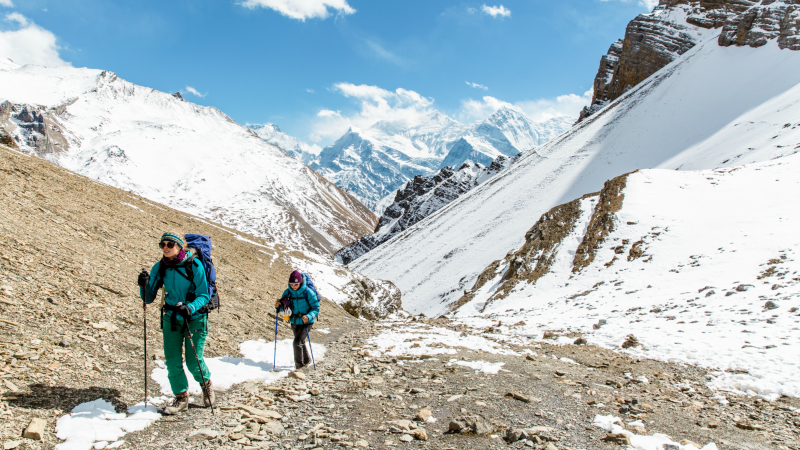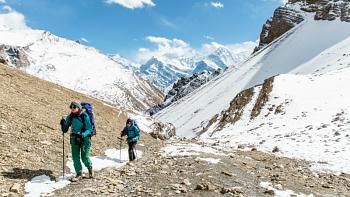Top 15 Things To Know About In A Hiking Trip Of A Lifetime To Nepal
Home to the world’s highest mountains, Nepal is a large playground for adventure seeking lovers of the great outdoors.
Nepal’s dramatic landscapes, cloud-kissing mountains and lush forests attracts trekkers and hikers from all over the world. Also, with Nepal’s fantastic trekking infrastructure, one doesn’t need to do a lot of prior preparations other than arranging a trekking or hiking permit and begin walking the creaking glaciers and knife-edge mountain passes. However, in a country with a vast number of mountains, choosing which one to begin with is no easy task.
There are dozens of hiking regions in Nepal, like the looping trek encircling Annapurna Range near Pokhara or others within walking distance of Kathmandu, the capital, but Everest Base Camp (EBC) remains one of the most sought-after treks in the world.
Here are top tips to keep in mind as you embark on a hike of a lifetime in Nepal.
1. Choose your hiking option—group or solo, guided or unguided?
For hikers travelling alone, you can choose to join a group to help lower costs and provide enough entertainment along the walk. Also, choosing to hike solo can allow for a lot more flexibility in your hiking itinerary. While self-guidance is quite possible for those with prior exposure to high altitudes, it is compulsory for those who are in doubt to be accompanied by a guide. This can particularly be useful in crisis situations—where the hiker suffers from altitude sickness—experienced professional guides can effectively manage such situations.
2. There are two trekking seasons
Nepal has two best seasons for trekking; spring (which begins in February and ends in May) with temperature of about 30˚C and Autumn, occurring between September and November.
The weather is generally dryer during Autumn, providing the perfect conditions to take in the spectacular scenery, before the snow arrives in December.
3. Begin the adventure from the Lukla airport
Most people might choose to take a bus from Kathmandu to Jiri or Salleri and then do some extra hiking for a few days towards the famous EBC trail. But, choosing to fly is no less adventurous as you can witness some of the best view when flying to Lukla.
Additionally, there’s the thrill of having to touchdown on the infamously short, mountainside landing strip.
4. Leave room for ‘complexities’ when booking flights
The airport in Lukla is a mountainside airport, indicating that it is likely to be affected by weather fronts which leads to flight delays or cancellations due to safety reasons.
However, to ensure that such complexities don’t affect your return flight, it is advisable to give yourself a couple days grace after you are scheduled to return form Lukla o Kathmandu.
5. Be sure to have your entire trip insured
While hiking in Nepal—particularly the Everest Base Camp—you should ensure that your health insurance plan covers for altitudes up to 5,645m. Don’t rely solely on the fact that may be are a trained professional and in perfect health condition, as altitude sickness can still affect you.
Keep it at the back of your mind when planning hiking trips that most standard insurance polices have a maximum altitude cap, so always make sufficient enquiries.
6. Use an experienced company as your hiking guide
In Nepal, there are a vast number of hiking guides to choose from. However, it is best to plan your trip and select the best hiking guide before even arriving the country.
The Nepal Hiking Teamis a great option for trekkers, hikers and mountaineers as they provide a comprehensive well-rounded travel package for tourist in Nepal. With over 10 years of experience leading successful expenditures in Nepal, Nepal Hiking Team have well trained professional guides with vast knowledge about places, culture and history and are popular for their cheerful, friendly and caring attitude. You’re can be rest assured of experiencing the time of your life.
7. Deciding to use a porter or not
Porter can be quite useful in carry additional gears to make your hike a lot more enjoyable—as you’re only left with a daypack for the day’s hike. Hiring a porter costs around $15 per day on the EBC hike and they can carry up to 25kg, which is the typical weight for two people’s gear.
However, it’s not a necessity as some hikers still feel comfortable carry all their gears by themselves. So, the choice is yours to make.
8. Get kitted out in Thamel, Kathmandu
In Thamel, hikers can choose to either buy or rent their hiking gears.
So, to get the best deal out of your gear purchase, consult your hiking company for the recommended kit list for the season you’re hiking in to narrow down your options.
9. Take Nepali Rupees along
For hikers on the EBC trail, it is necessary to bring cash along from Kathmandu as there are no ATMs along the way.
Currency exchangers on the trail offer inflated rates so it’s advisable to bring the local currency, Nepali Rupees along. Your hiking company can provide suitable advice on how much cash you would need depending on the agreed payment, level of accommodation and the trip duration.
10. Carry a book or playing cards
Due to the need to acclimatise, the hours you may spend on the move everyday would be limited. Therefore, on the way up, there are days where you are most likely to hike for only two or there hours and there is very little to do in the mountain villages.
However, in some hiking trails—like in the Annapurna Region—the village café offers tasty apple pies, donuts and brownies, or you can snuggle up by the teahouse stoke with a book or playing cards.
11. Bring a battery pack
To get the most out of your hike, it is essential to preload a battery pack to charge your gadgets—particularly your camera or smartphone—while on the trail. Though lodges have charging points at a small hourly cost which the locals use to support themselves as electricity is solar generated.
Also, it’s important to place anything you don’t want freezing, most importantly batteries, into your sleeping bag with you overnight.
12. Carry a reusable water bottle
As the altitude increases, there is a much greater need to drink plenty of water. Most local water sources are drinkable once purified, so carry along a reusable water bottle—or even two as the case may be.
13. Know the essential toiletries to pack
Must haves in your backpack is a sun cream, SPF lip balm, loo roll, wet wipes and biodegradable hand wash. It is also recommended to carry dry throat lozenges to relief the common Khumbu cough, paracetamol and aspirin.
14. Visit the Kala Patthar peak for sunset views
Depending on how your acclimatisation goes, your hiking guide will most likely suggest the option of climber to even higher distances to the 5,645m peak of Kala Patthar.
There you would have a spectacular view of Mount Everest and if the weather is clear, it is usually the best time to experience the sunset when the sunlight can turn the world’s tallest mountain pink.
15. Always stay sensitive to symptoms of altitude sickness
For may hikers who hike above 4,000m altitude sickness is a very troubling situation. For trails such as the EverestBase Camp—which is approximately 5,380m—hikers are likely to be constantly faced with the risk of altitude sickness.
There are quite a number of symptoms and each body experiences it differently, so it’s important to keep watch. Altitude sickness can escalate quickly, and most often leads to death so ensure to keep a regular dialogue with your guide.
Typically, eating garlic, drinking lots of water, and perhaps using Diamox can reduce the symptoms, however descent is the only cure.
Comments
There are 0 comments on this post













